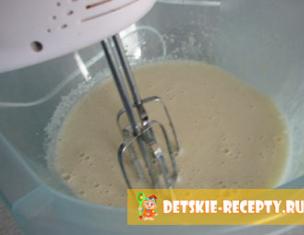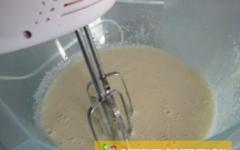It is more difficult if the room is small - you will have to carefully consider the location of all the necessary items.
Typically, cereals take up a lot of space, and packets of spices cause chaos because they spontaneously spread over all surfaces (plus odors).
Here are our tips on this topic. Let's start from the opposite, that is, what not to do.
Where should you not store cereals and spices?
It is impossible to begin deciding on the placement of bulk products without understanding which places are best to avoid.
- First of all, you need to remember that Storage in bags and cardboard boxes is strictly prohibited. Avoid this if you don't want .
Note: Spices also do not tolerate such storage conditions well - they quickly lose their aroma. And in general, the taste of products deteriorates if they are not stored. - Poor choices include drawers and shelves above the kitchen sink. High humidity promotes the formation of dampness and, as a result, mold. And if cheese with it can be considered a delicacy, then hardly anyone would consider moldy buckwheat a gourmet delicacy.
- Storing cereals in the refrigerator is not the best option. Firstly, condensation may form there and they will become damp. Secondly, they will simply take up space there - bulk products do not need to be kept cold for preservation, just a dry place and sealed containers are enough.
Having figured out where it is better not to place cereals and spices, let's choose nine best options that will help you organize them in a small kitchen.
There are many interesting ideas for storing cereals and spices that are easy to implement with your own hands. Let's see the most original and convenient ones?
Secret sliding panel
It is not necessary to put your culinary supplies on public display - they can be disguised. For example, by building a retractable shelf into a kitchen set, which will look like an ordinary decorative panel.

This method is quite unusual, but requires significant costs: you will have to purchase a custom-made kitchen. However, the final result is worth it - few people can hold back an exclamation of surprise when they see how you take out pasta or seasonings for it from the seemingly solid wall of the set.
Hanging shelves for refrigerator
If you have easy access to the side wall of the refrigerator, a wall-mounted structure that can accommodate sealed jars for bulk products can be a great solution for a small kitchen.

This way they won’t take up precious space on the shelves, but will always be in order and in sight. This method is a kind of organizer that will greatly facilitate the search for the necessary ingredients for cooking.
Tip: For a white refrigerator, choose shelves that match the color scheme in the kitchen. If you bought a more original colored unit, choose a suspended structure in a contrasting shade.
Retro cabinet
A hanging wooden cabinet with glass doors and iron handles looks good. It fits well into a kitchen decorated in a classic style. You can arrange the drawers symmetrically, or you can arrange them in a chaotic order, alternating the sizes and colors of the doors.

This option looks impressive, but it is necessary to take into account some nuances. The first of them is price. Most likely, the cabinet will need to be custom-made to suit the color scheme of your kitchen. The second can be considered more significant - if the product is of poor quality, you will not be able to ensure the tightness of the products, which will negatively affect their shelf life and may become cause of kitchen moths.
Alchemy laboratory
Probably, almost everyone dreamed of becoming a wizard in childhood. Now you can at least partially realize your dreams! Small narrow test tubes with spices and wide flasks with cereals and pasta will look very impressive on a hanging shelf.

You can also add mystery bottles of vinegar and vegetable oils. This design looks very interesting and mysterious. However, be careful not to hang it over the stove, even if your beakers are heat-resistant: constant heating does not improve the properties of the food.
Interesting trick: Containers with glass of different colors can add originality to an already interesting idea. If you decide to place vegetable oils on this shelf, make them aromatic - add herbs or berries to them. This will make your shelf look even more like the shelf of a wise wizard.
Hanging stand
Containers hung by strong hooks on a metal or wooden sheet on the wall look non-standard. You may have to make it protruding in order to organically place containers with cereals. It is better to choose oblong narrow containers. 
When using this design technique, you must take into account that it looks best in kitchens decorated in a modern style. In addition, it will be difficult to arrange containers of different sizes beautifully - it may be better to use the method only for cereals or spices. In this case, it is better to come up with another option for the second type of product.
Magnetic board
This storage method is more suitable for spices - after all, large containers will look a little strange, and placing small containers on the board is much easier.

The essence of the technique is quite simple: A sheet with magnetic properties is attached to the wall in a convenient place. Then small jars with metal lids or magnets on the walls are selected. Then everything is simple: attach them in a random or strictly defined order, depending on your taste.
It is not necessary to purchase special containers for this. Clean jars of tick-tock dragees, signed in a beautiful font, look original. Simply attach a ribbon with an inscription to one part and a small magnet to the other.
For a large kitchen: If you want to use this technique for cereals, you will need a lot of space, a magnetic board and stronger magnets. Select containers that are not too heavy and think about the location so that it is convenient for you to reach each jar.
Rack with pull-out shelves
A small narrow cabinet with pull-out shelves will also look original. You can see these in the supermarket. Make several large drawers for cereals and pasta, a couple of smaller ones for coffee and tea, and very tiny ones for spices.

Such a cabinet, especially if it is designed to match a kitchen set, will look organic. Pull-out shelves make it easier to find the products you need and organize the arrangement of products.
If you are not a fan of large stocks, you can make such a rack in the form of a small decorative cabinet placed on the kitchen panel or built into the set. In any case, such shelves are convenient and easy to implement.
As a decor for the kitchen
Love a rustic-style space? Then post beautiful jars for spices, cereals, tea and coffee on small open shelves. Choose cute lids for them - for example, wrapped in fabric. It is not necessary to buy them identical: on the contrary, different ones, but decorated in the same style, will look better.

Do not place more than two or three containers on one shelf - this creates an overloaded effect and does not look as impressive as five or six shelves with several cans.
As for the sizes, also show your imagination - select containers of different sizes, but of the same shape. In this case, the kitchen will not look boring, but you will be able to avoid clumsiness.
Interesting addition: Don't try to place the spices like this. Small, lightweight jars are difficult to keep organized on an open shelf. It's better to place them in a small wall basket. Alternatively, it can be hung from one of the shelves. Just make sure the fasteners are strong enough.
Drawers
Probably, almost everyone has seen racks for selling tea and coffee - a large number of small sealed boxes with transparent side doors.

You can allocate a separate area in the kitchen for such tanks, or you can order an original kitchen set, where such tanks are installed in any order. This will add originality to the kitchen and will look like an original design technique.
The price for such a set will be high, but the final result will please any lover of original furniture.
However, there is one caveat. If you are not particularly careful, you will have to refuse this option. You will have to be careful to keep the clear doors clean and the containers full. Half-empty, they will not look so aesthetically pleasing.
As you can see, there are many ideas that completely refute the standard ideas about how you can store spices and bulk products in the kitchen. We tried to collect the most original solutions for you, but this does not mean that you should limit yourself exclusively to them.
You can use one of our ideas for storing cereals and dried herbs, or you can come up with your own based on them. Don’t be afraid to experiment with interior design - perhaps you will be the one who can say a new word in kitchen design.
The cereal is suitable for long-term storage; it can be used at the place of production or transported to different distances, including long distances.
In the practice of storing cereals, it is necessary to take into account the same properties as those of the grain mass. Cereals are stored at cereal factories, warehouses and bases of the Ministry of Agriculture and Food, and less often - at bases, warehouses and trade and public catering enterprises.
Various methods are used to store cereals. The oldest and most common method of storage is in textile containers made from various fabrics. Linen, jute, cotton and mixed bags with a capacity of 50-70 kg are used. Also, cereals are packaged in small containers of 1-3 kg, stored in boxes or boxes on pallets or racks.
Storage of cereals can be carried out both in heated and unheated warehouses, but it must be dry, clean, well-lit and ventilated, not infested with pests of grain stocks, separately from sharp-smelling and perishable goods. Optimal environmental parameters: relative air humidity 60-70%, temperature from 5 to 15 °C.
Transportation of cereals over long distances is carried out in railway cars and vehicles. When transporting by rail, it is necessary to use absolutely dry, clean wagons that do not have any foreign odors for loading products. In wagons, sacks are placed on pallets at a distance of 0.5 m from the walls, leaving a passage between the stacks.
During rail transportation, the natural loss of cereals should not exceed 0.09% for a distance of up to 1000 km and 0.13% for a distance of 1000 to 2000 km.
When transporting by road, it is also necessary to use dry, clean vehicles in which no pungent-smelling substances were transported, and conditions of soaking or contamination must be excluded.
Transporting cereals in containers is associated with large costs, packaging costs, the use of physical labor, and sometimes leads to spoilage and contamination of products. The transition to bulk storage and transportation according to the scheme: dump bin of a cereal plant -> wagon -> tank - receiving hopper of a packaging factory can provide greater savings and better preservation of cereals.
Packaging and labeling
Cereals are usually packaged in jute, flax-jute or cotton bags with a net weight of 65 to 70 kg. Each of them has a marking label made of paper or cardboard, which indicates the name of the product, its type, grade, net weight, production date and standard number. A significant part of the cereal is packaged directly at cereal factories in single-layer paper or cellophane bags of 900 g.
Hello, friends! We continue the topic of rational and proper food storage, begun in previous posts and.
Today we’ll talk about how to properly organize food storage outside the refrigerator. This applies to all kinds of cereals, sugar, flour, etc.
To be honest, sometimes hordes of gray midges, similar to ordinary moths, suddenly begin to fly out of the depths of our food pantries. Or suddenly, having opened a fallen bag of cereal or flour, we find in it, in addition to the contents we need, some other creatures - small worms that turned our buckwheat into crushed flour.
All kinds of bugs: grain borers, granary weevils, rice weevils, flour beetles, Suriname flour beetles, pea weevils, grain and flour moths - this is not a complete list of those small pests that seek to destroy our food supplies.
And this is information for thought, a signal for immediate action and a call to urgently clean up your pantry.
How to store food in order to prevent the appearance of all sorts of animals that we don’t need in the food? I have my own methods for this ruthless struggle (I think they are familiar to many of you).
And the first thing I do...
All jars, bags and sachets, spices, seasonings, cereals and everything else are unloaded onto the table, any free surface, even onto the floor. The kitchen, of course, at this time turns into something slightly reminiscent of a landfill.
That is OK. This won't last long and you can be patient. And the pleasure gained from looking at the orderly rows of your packages, jars and other storage containers on perfectly clean shelves will fully compensate for the time and effort spent.

The purpose of such a total evacuation from cabinets:
- this way I can see all my supplies at once and can easily sort them by type (cereals to cereals, seasonings to seasonings, spices to spices, etc.)
- throw away everything that has been lying around in my closet since Soviet times (it’s true, not so long ago I found reserves of potted pepper, which I bought in large quantities back in the 80s for the occasion)
Inventory audit
I definitely check all the cans of preserves and twists. If I find something swollen, leaking liquid, rusted, the same fate awaits them - a trash can.
Probably everyone has some products that you have not used for quite a long time. Everything seems to be fine with them, they are not spoiled, but for some reason they are not eaten. Most likely, you will never eat them.
I also try to get rid of them during total checks. Why should they take up space in the closet, because in the end you will throw them away anyway.

Then comes the turn of various jars, bags and boxes with various cereals, buckwheat, rice, millet, bags of flour, breakfast cereals, various mixtures, breadcrumbs, pancake flour and everything else that is stored in my bins. The weevil simply loves to settle in such products.
If you are not sure whether your product is infested with a pest (this can be difficult to check if you have large supplies, such as a bag of flour), you can neutralize the pest with cold. Frost kills the larvae. To do this, you can keep the product for at least one day in the freezer (again, if possible) or, if it is winter, freeze it, for example, on the balcony.
And if there are no conditions for long-term storage of large stocks of food, it is better not to make them. It will be much more economical to buy a little more than you need for a short period of time. This way you will definitely eat everything yourself, and the bugs won’t have time to feast on your supplies.
And in order to finally neutralize the activity of all insects in destroying family supplies (and, consequently, the money spent on their purchase), I proceed to the next decisive step...
General cleaning of the pantry
I wipe the shelves and cabinet walls with a well-absorbing cloth soaked in a soapy solution. I usually use microfiber cloths for this purpose, I really like them.
Then I wipe everything dry. Pay special attention to the gaps where the shelves meet the walls. Usually all sorts of crumbs and grains from spilled cereal are clogged there.
They must be removed because they can become a breeding ground for new food pests. I usually clean these surfaces with a vacuum cleaner fitted with a crevice attachment.
Then on the shelves, especially those where bottles of oil and jars of jam and pickles will be stored, I spread either clean paper or pieces of clean cloth, or even better, something that does not allow moisture to pass through.
And again - cleanliness and order
Yes, before I put everything in my cupboards back into place, I usually check what I'm running out of and what items I need to add to my grocery list when I head to the store.

Numerous containers for storing food of various shapes and sizes, racks and other useful devices help put everything in its place, eliminate clutter and chaos from your favorite kitchen.
I try to use containers of various shapes, but round ones are undesirable. The round shape does not allow rational organization of space on the shelf.
I arrange products so that those that are needed often or are ready to eat are in the foreground and are easy to get. And then I arrange the bags and containers that I use from time to time.
I try to store bulk products and various cereals in airtight containers, preferably transparent (then you can clearly see how much you have left) or in store packaging, if it has not yet been damaged.
I usually leave the bottom shelves for storing canned goods. It's safer this way. It’s not very pleasant if a heavy can of canned food falls on someone’s head from the top shelf. In addition, if something leaks, other products will not get dirty.

To make more efficient use of space, the shelf can be divided into 2 parts using special folding structures that are inserted inside the cabinet. This is a very good idea: you can buy such metal folding shelves in a store (I have seen many such offers in online stores).
I also really like the wall shelves that hang on the inside of the cabinet door. You can store all sorts of small things there.
I store potatoes, onions, and garlic in a dry and preferably cool place and in special baskets for storing vegetables and fruits.
If the family has children or people with diabetes, or simply one of the family members is on a special diet, it is better for them to store food on a separate shelf.
I have several sections in my closet to store pots, pans, and large cups. Everything is in one place and it is very convenient.
Household kitchen appliances and various accessories (mixer, food measures, sieve for sifting flour, etc.) are also stored separately.
I try to sort all the contents of kitchen cabinets by type of product or their purpose: spices - separately, canned food - separately, vegetables - separately, dishes and kitchen utensils - separately.
This makes it very easy and quick to find everything you may need at the moment.
You can watch some tips on how to better organize your kitchen space for storing cereals, pasta, flour, spices and other bulk products, as well as vinegar, oil and other products that do not require storage in the refrigerator in this short video:
These are the simple ways. And the savings are good.
Everything's under control
And also, in order to give the process of home saving a more or less organized look and clearly see what has been spent and what has been saved, you need to control your income and expenses.
How to do it? There are a lot of ways: there are special programs with which you can easily identify all the mistakes in your home financial policy and learn to draw the right conclusions, you can keep diaries.
I do this the old way: I write it down in a notebook. I like it better this way.
This method helps me very easily understand where and what I spent the money on. What I wasted it on and what products I could have done without. What products did I throw away and why?
This is all not difficult, but believe me, next time you are unlikely to waste money on the products that you most often throw away in your family.
I look forward to your comments, advice and thoughts.
In the diet of most of our compatriots, it is cereals that occupy a special place. Moreover, if we take into account the fact that their cost level is far from minimal, we should approach the process of storing cereals taking into account as many features as possible.

Basic Rules
To store cereals correctly at home to prevent moths, our ideas and recommendations will help you. According to many experts, the most favorable option is to store cereals in the bags (mainly paper or plastic) in which they were previously sold. The only drawback is their poor quality. But replacement is necessary only in extreme cases. Semolina is perfectly stored in plastic bottles or tin cans. Containers for buckwheat are containers.
Before storing the product, it is necessary to carefully inspect and sort it out. A common and not very pleasant phenomenon may be the presence of many small insects in the cereal. If the grains are not sorted and subsequently dried at medium temperature in the oven, you may encounter the proliferation of various spiders and their damage to other food products. If this was found in rice, the package of cereal should be placed in the freezer for a day. This will simultaneously help you defeat the spiders and fully preserve all the beneficial substances.


Everyone who at least once tried to make significant reserves of cereals was faced with the fact that small insects began to crawl out of them over time. You can cope with this problem using traditional folk remedies. For example, spread dried calendula at the bottom of the shelf on which the containers will stand. An alternative option could be garlic cloves placed in the corners of the appropriate place.
It is necessary to implement such a recommendation only on the condition that all cereals are stored in hermetically sealed containers, which minimizes the risk of their impregnation with foreign odors. Another general rule for storing cereals is to avoid the presence of strong-smelling substances (household chemicals, spices) nearby.

Selecting a location
At the present stage of development of room design, including kitchens, there are many options for storing cereals. Some people purchase special stands for this (depending on individual preferences and skills, they can be made independently), others use specially designed shelves for this, which can be considered as an original option for complementing the interior.
In any case, you need to remember that there should be a problem-free approach to the place where the containers with cereals are located; the housewife should be able to get to it without any discomfort. When storing cereals, you need to take into account the need to avoid direct sunlight, as well as sharp fluctuations in humidity levels and room temperature.

Temperature and humidity
Almost every person has encountered the phenomenon of rancid cereal at least once in their life. One of the most common factors that provoke its occurrence is precisely too high humidity. To preserve such products in normal condition, it is necessary that it does not exceed 65–70%.
Sometimes, under the influence of a number of external factors, the level of humidity can fluctuate, which affects the cereals accordingly. Therefore, it is necessary to empty them out at least once a month and carefully inspect them. If there is an unpleasant taste or odor, you must immediately discard the product and rinse the container thoroughly using special disinfectants.

As for the temperature regime, its optimal indicators should vary from +15 to +20 degrees. It must be remembered that cereals are capable of maintaining the temperature at which they were before for a long period. Therefore, if they have been in the sun for a long period or, conversely, in a room with a relatively low temperature, it is worth leaving the cereal in the room at room temperature and after that ensure proper storage.

How to choose a container?
Depending on the container in which the cereal is stored, its taste and shelf life depend. The most common materials used to make tableware include the following:
- glass;
- ceramics;
- linen or cotton fabric;
- tree;
- food plastic.



The need to preserve the product in the container in which it was purchased has already been noted. At the same time, the use of ordinary plastic bags, especially if they are not tightly closed, is not advisable. There is a risk that the cereal will mate, which will negatively affect its taste. Many people prefer to store products in special glass containers, since in this case foreign odors and moisture do not penetrate. The main thing is that you can prevent the occurrence of pests that cause significant harm to food.
Some companies strive to produce such containers in different volumes and taking into account an original design approach, which makes it possible to implement the most daring and non-standard approaches to solving the problem of decorating a room in the kitchen. The negative point is the significant cost of such containers, so ordinary glass jars can be a replacement option. Initially, they must be thoroughly washed to get rid of foreign odors and dried. Another negative point may be increased fragility, as well as heavy weight. Handle such a container with extreme care to avoid cracks and glass particles getting into the food.

Plastic containers for storing cereals can be a kind of prototype. When choosing them, it is important to pay attention to the fact that they are made of a material that can be used for storing food. Most of them are equipped with a special dispenser, which makes it possible to make the process of pouring cereals more acceptable and faster. Thanks to their light weight, kitchen cabinets can accommodate many jars without the risk of overloading the cabinet.
Our mothers and grandmothers used iron containers to store cereals. Despite the fact that at first glance they seem quite reliable, the process of using them must be extremely careful. For example, you need to remember that they can rust. If the relevant elements enter the product, it may be considered completely unfit for consumption. A controversial option for high-quality storage of cereals are containers made from various types of wood. It seems that they are completely environmentally friendly and easy to use, but it is wood that actively absorbs foreign odors, which can cause irreparable harm to the product.
It is believed that containers for storing cereals made of ceramics help maintain all the necessary qualities for a long period. This is true, but the material itself is very heavy and fragile, which creates additional problems in its use. For many centuries, storage took place in fabric bags made from flax; it is advisable to initially wash them in salt and then iron them, which will help protect them from insects. This option is especially favorable for flour, millet and oats. A significant drawback can be considered instability to moisture.

Best before date
Contrary to the popular belief that all cereals have the same shelf life and storage conditions, in reality the situation is completely different. Of course, it is necessary to remember that everything depends on the endurance of the technological processes, as well as on the type of product. If we talk about the most common options, in this case the following terms are observed:
- wheat groats, processed in different ways, can be stored for no more than 16 months;
- barley porridge has a similar shelf life;
- rice - the maximum shelf life of nutrients and taste is one and a half years;
- oat flakes are usable for no more than 4 months from the date of their preparation; if we are talking about muesli (depending on how well the dried fruits are prepared), the period under consideration can be reduced several times;
- peas that have undergone the grinding process and rice that have been parboiled are used for 2.5 years.

Important! Every decent manufacturer must indicate the date of manufacture, duration of storage and conditions under which the product can retain its positive qualities. Deviation from these standards may indicate a decrease in shelf life, but in no case does it increase it.
Danger of improper storage
If you store food without taking into account the level of humidity, you can note a significant risk of the occurrence and rapid development of mold. In addition to the fact that it destroys products, giving them a not very pleasant taste and smell, active production of toxins occurs. Eating grains contaminated with mold can cause severe poisoning and can sometimes be life-threatening. Previously, attention was drawn to the high risk of insects infesting this product category.
In addition to the not very aesthetically attractive appearance of the products, they also provoke their poisoning and almost complete unsuitability for human consumption due to the high content of waste products.


Most cereals, despite the fact that their shelf life has long expired, do not change their appearance. But such products no longer contain the required amount of vitamins and microelements, and their taste also leaves much to be desired. Anyone who seeks to purchase products for future use must make appropriate notes on all containers, which will display the date of storage. Then organizing a normal nutrition process will become much easier.
In order to avoid expired products in the kitchen, it is necessary to conduct an audit of the kitchen at least once every six months, examining all expiration dates. By the way, if cereals are stored next to seasonings that have a strong odor, you must be aware of the increasing risk of food allergies.
Among many housewives, there is an opinion that it is best to store cereals in the refrigerator, as this will help save them from insects and the loss of nutrients. In fact, this does not correspond to reality, and excessive hypothermia, just like drying out a product, can lead to faster spoilage and loss of a significant part of the nutrients. If you purchase cereal by weight, and not in a bag sealed at the factory, you need to smell it well and pass it through your fingers.
Under no circumstances should there be any foreign odors, lumps or, so to speak, the feeling of dirty hands. Otherwise, you need to give up the idea of purchasing such low-quality products.

When examining cereals sold already packaged, you need to pay attention to whether there are any foreign inclusions (a number of unscrupulous manufacturers can sell a surrogate) and whether the packaging is intact. Despite the fact that on the Internet you can find a whole range of measures to ensure the rehabilitation of cereals after damage by insects, it is best not to take risks.
It must be remembered that even minor particles of vital activity can lead to negative consequences in the form of health problems.
To learn how to store cereals to prevent bugs from getting in, see the following video.
Maintaining order in the kitchen is not so easy - as a rule, the kitchen set cannot cope with dishes, appliances and other utensils. But we have a solution: with the help of little tricks you will not only clean up your kitchen, but also save interior space. Read and get started!
Idea No. 1: strictly vertical
A vertical storage system is the best solution for a small kitchen. Compact shelves will not take up much space, but will easily accommodate all your dishes.
Idea #2: Out of sight
And pull-out mesh baskets inside kitchen cabinets make a great place to secretly hide cleaning supplies.

Idea No. 3: in limbo
In addition, do not forget about hanging mesh baskets, which are convenient for storing not only cups, but also vegetables and fruits.

Idea No. 4: side by side horizontally
The functionality of the kitchen can be easily increased with the help of roof rails. Today, many different modules, hooks, and special jars for spices are produced for them.

Idea #5: Side by Side
There can never be too many shelves - by purchasing several additional mesh baskets in chrome color, you will forever solve the problem of storing dishes.

Idea #6: in plain sight
It's not easy to put all the pots and pans in one kitchen drawer! It's better to hang them next to the hood or on the wall near the door. A special perforated wall panel will help you with this.

Idea No. 7: original approach
The space in the very corner of the kitchen is quite difficult to use. Special pull-out racks and corner drawers of a special design will help solve this problem.

Idea No. 8: cleanliness and order
Use drawer dividers to make them more functional. Now it will be much easier to maintain order!

Idea #9: Gravity
Attach your knives to the wall—literally. A special magnetic bar will show them who's boss!

Idea No. 10: Spice House
You can also store jars of spices on magnets. Attach them, for example, to the wall of a refrigerator or the inside door of a cabinet.

Idea #11: Take the heights
Use special racks for pans and pots - this way you can use the entire space of the drawer and you won’t have to sort them out before each cooking.

Idea No. 12: successfully hooked
And bulky lids from frying pans and pots can be conveniently stored using simple crossbars: attach them to the free surface of the wall in a place convenient for you.

Idea No. 13: along the wall
Metal pocket shelves will help you place lids on the wall of your kitchen cabinet. If the cabinet is completely occupied, such a shelf can be placed outside the cabinet.

Idea No. 14: everything in its place!
Inside the cabinet it is convenient to store not only dishes, but also narrow boxes of pasta and dough. Just attach a vertical storage unit to the door - and it will fully justify its new place.

Idea No. 15: shabby chic style
And in order not to reach into the far corners of the kitchen for rolls of foil or film, hang them directly on the wall - using an old hanger.

Idea No. 16: in the access zone
Remember how convenient it is to view postcards or small souvenirs on turntables in a store. Add several mobile shelves to one of the cabinets - and all the jars and containers with spices will always be at hand.

Idea #17: Under Control
Tired of cleaning out crumbs from your candy drawer? Solve this problem once and for all by pinching the cookie packages with a regular clothespin.

Idea No. 18: Helper shortcuts
To no longer waste time looking for salt or sugar, label the lids of the jars in which you store cereals and grains.

Idea No. 19: complete order
Organizing recipes will help speed up the cooking process. No more rushing around the kitchen: put all the recipes in one place, or better yet, in alphabetical order.

Idea #20: Practical Example
Wall cabinets have too little space! Attach hooks to shelves and hang coffee cups on them. And store glasses under shelves - upside down.

Idea #21: Stand in a Line
Long, narrow shelves easily attach to the wall and are ideal for storing spices and a variety of bottles of oils.

Idea No. 22: a place in the sun
At the very top of the kitchen unit you need to put something that you rarely use. For example, let it be baskets with alcohol or dishes for preparing holiday dishes.

Idea No. 23: surprise rack
And various modules, shelves and racks will help you use even the narrowest and most inconvenient places. For example, pull-out kitchen cabinets.

Idea No. 24: for the little ones
Numerous spices belong in Tic-Tac containers. Just don't forget to sign them!

Idea No. 25: spectacular decor
Dishes can be stored not only in closed cabinets, but also on narrow open shelves. Let your favorite set become an original kitchen decor!

Idea #26: basket for boards
No more cutting boards will end up in the sink when you introduce them to a space-saving basket. Choose models made from artificial rattan, a moisture-resistant material.

Idea #27: Budget Idea
Do not throw away tin cans and rusted rakes, because if properly treated, they can be useful for storing kitchen accessories - spoons, forks and spatulas.

Idea #28: Smart Approach
And you can make compact magnetic shelves for small items with your own hands. You will need small baskets from the hardware store, magnets and superglue.

Idea #29: Go home!
By purchasing several plastic containers for sorting food, you will not only free up space in your refrigerator, but also make it easier to clean.

Idea #30: little tricks
Don’t forget to use the lower parts of the cabinets - it’s convenient to store cereals and grains, as well as materials for creativity and handicrafts, in drawers or baskets directly under the set.










